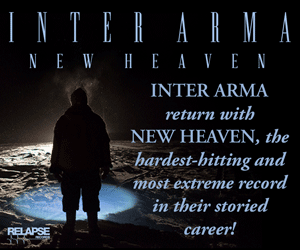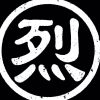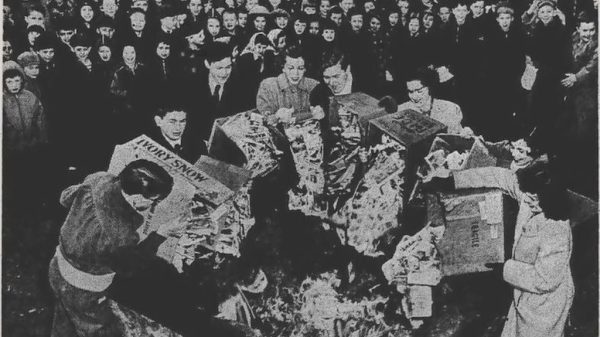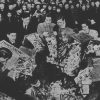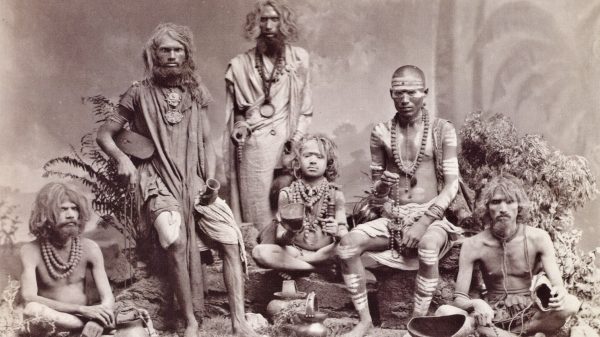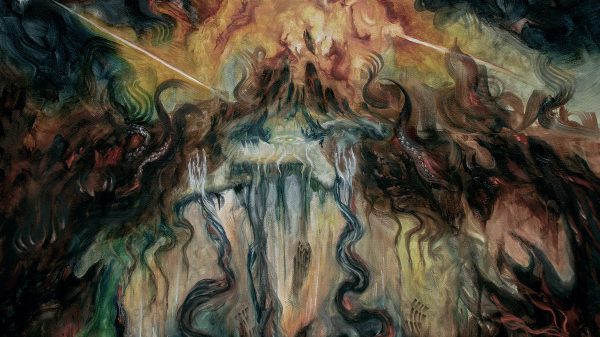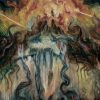David D’Andrea’s art combines 60’s concert posters with ancient religious iconography and various other occult miscellany and ephemera. His sinuous pen and ink drawings are perhaps most recognizable on his posters for bands including Sleep, High On Fire, Om and many more. He runs his own printing company under the name Samaritan Press, which sells everything from special edition 7″ records, t-shirts, books, band posters, books and original art. His interest, visual and otherwise, are wide, but connected by some strong common threads. David graciously took some time out of his busy schedule to answer some questions about his art, process and inner workings.
Can you describe the process of developing your personal aesthetic/style? Was it an intentional, focused path or did it take a lot of experimentation?
It has been a very natural progression. I’ve led a life obsessed with art and design. This obsession has been fairly focused but also habitually morphing. As a visual artist I believe it’s best to play the long game, to develop a style and body of work over decades. Any working artist will know that this can be tricky because once one is known for a particular style it can be difficult to break free.
The experimentation becomes increasingly important as an artist moves on because at first the influences might be apparent. With experimentation a more unique style is developed. Riffing off of contemporaries is great but there comes a point where an artist should consider the authenticity of their work. There can certainly be broad art movements or schools of style, but since today’s culture is prone to misunderstanding or disregard for originality in exchange for instant recognition or income, I try to stay true to my vision.
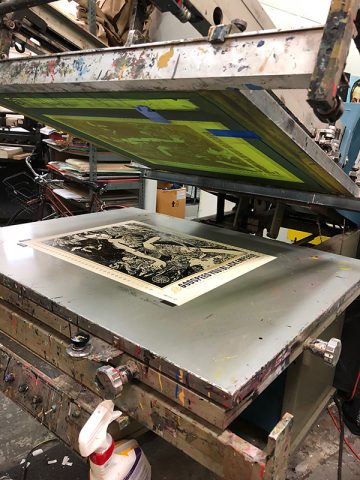 Being someone who is primarily a visual artist, but also steeped in the music scene, how do you see image relating to music? How can art intensify or compliment a piece of music?
Being someone who is primarily a visual artist, but also steeped in the music scene, how do you see image relating to music? How can art intensify or compliment a piece of music?
I’ve always recognized the connection between visual art and music and it was a role that I took on once I realized there was an actual niche to fill. At a young age I noted that somebody painted the cover of Kiss Destroyer specifically to enhance that experience.
Better yet, a more interesting example, the sleeve of Cream Disraeli Gears. This artwork encourages an interactive experience of tripping around the image while the music plays. The maze in the Rolling Stones Their Satanic Majesties Request gatefold even more so! On my father’s copy, somebody had actually drawn along the maze path with a pen.
Unfortunately, there is a reason these examples are all from certain time period. We’re living in the wrong era for full-on immersion. Album artwork has largely been reduced to a 300 pixel image or whatever. This isn’t the fault or preference of bands and labels, just a symptom of the industry. There seems to be very little money in the budget for art. I’ve been able to do a few album covers that I am proud of, but even in my time as an illustrator I’ve seen a shift.
I’ve created the antithesis with the means and budget available to me by collaborating with Al Cisneros on a Samaritan Press 7 ”. Al created two tracks specifically for the project. I made the artwork to coincide with the music without any art direction or digital print methods. Using my letterpress, Risograph, and rubber stamps I sought to create a very tactile and specific package, an art object if you will. The edition of 1000 is just about sold out.
I’ve been working on the second release in this vein , a 7” by another one of my favorite musicians Steven R. Smith. Steven was previously in the Thuja/Jeweled Antler Collective which I greatly admire. His current work is under his own name or various monikers (Ulaan Khol, Hala Strana, Ulaan Passerine, etc).
Screen printed posters have been my main medium within the music world. I think this is largely because posters can be self published easily and I enjoy the analog printing methods. Posters enhance the live experience as a commemorative piece of art and they’re generally affordable, at least at the shows. Once on the wall they make for a nice inexpensive piece of art and people tend to collect certain artists or bands.
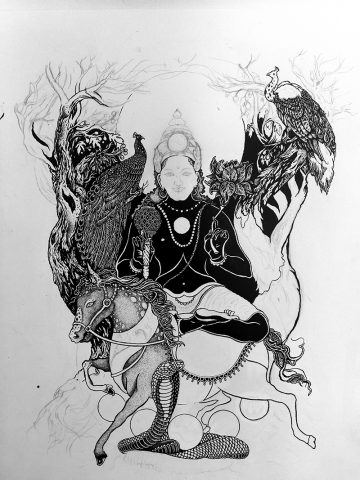
It’s impossible to know what paths would have been available to me and where they would’ve led. I’m ten plus years in as a “professional” and haven’t looked back since art school. Success is subjective. I haven’t found any practical benefits to having my name on a diploma, which would be the paradigm that’s upheld by the older generation, and I’m not sure it has ever applied to art unless you want to be a teacher. I was able to study with the great illustrator Barron Storey and a few other Bay Area teachers who were good at sharing their knowledge and experience.
I suppose a formal education should introduce some crucial aspects of an illustration career such as deadlines and working under pressure and an intense focus on work. It might create a sort of dedication to your work and role in society.
I enjoy the layout and design work you do. Do these factor into the original artwork or do you work the practical design elements in around an illustration?
Approximately 90% of a poster is usually one hand drawn piece. I collect ephemera which I scan and later incorporate into the layout. This includes lettering, borders, and misc bits. The energy of my hand drawn illustration can be killed by a clean border or type. I put an incredible amount of time into a drawing, so if I spend no thought on the layout or design elements it will look out of balance.
Have your sources of inspiration changed significantly since you were younger? Do you find yourself going back to certain works over and over again? If so, what are they?
Yes, they’ve shifted over the years though I don’t discount anything because it’s all stepping stones. I suppose the most notable difference is that pop culture based work isn’t really my main point of reference at this point. Instead, I try to gather inspiration from nature, self study, dreams, poetry, or spiritual texts.
I still go through phases and love to discover gems of art history. Some specific favorites are the book plates of Rockwell Kent, biblical illustrations of Dore, painted poetry of Basquiat, mixed media madness of Rauschenberg, the Pre Raphaelite haze of Rossetti, and on and on.
A psychedelic aesthetic is visible in your work and also reflected in the sound of a lot of the musicians/bands you work with. Did psychedelics and music orient you towards meditation and spirituality? Do they mirror each other in your experience?
Whether meditation/entheogens/spirituality meld is a personal opinion. For me, yes, it is all one. Everything is a tool in achieving some sort of truth or inner peace. I simply believe in a life long path of inner work with no limitations.
In my mind there should be a better term than “psychedelic.” Entheogen might be a better term to use. The term “psychedelics” so often makes people think of their experiences as a kid, often chaotic and sometimes terrible. Your adult mind is (hopefully) more at peace, more creative, and less prone to bad stimulus so all types of experimentation are valid. We all need to cultivate an open mind!
I see that you are a student of ashtanga yoga. Can you describe to readers what an ashtanga practice consists of?
Simply put, Ashtanga is a moving meditation. We use breath as a foundation and move through a series of postures. Each posture is a mudra (gesture), an infinite extension of the body into space. Ashtanga is an incredible and bountiful method of yoga. It requires hard work and discipline but can be a life long study like no other.
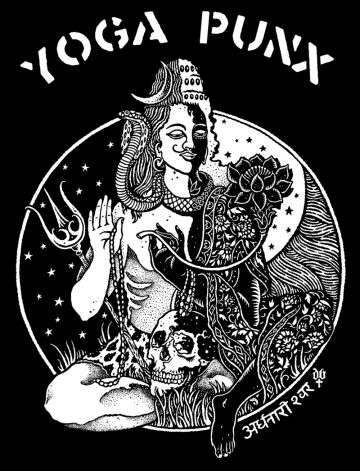 Ashtanga means “eight limbs or branches”, of which asana (physical posture) is just one branch. This is an important point because people often equate yoga with the physical practice only. The eight limbs are as follows: Yama (moral codes), Niyama (self study), Asana (posture), Pranayama (breath), Pratyahara (sense withdrawal), Dharana (concentration), Dhyana (meditation), and Samadhi (union with object of meditation). All of this makes up a vast hidden universe of things to learn and unlearn!
Ashtanga means “eight limbs or branches”, of which asana (physical posture) is just one branch. This is an important point because people often equate yoga with the physical practice only. The eight limbs are as follows: Yama (moral codes), Niyama (self study), Asana (posture), Pranayama (breath), Pratyahara (sense withdrawal), Dharana (concentration), Dhyana (meditation), and Samadhi (union with object of meditation). All of this makes up a vast hidden universe of things to learn and unlearn!
How did you find yoga and how does it inform your life and work?
My nature is very contemplative and spiritual so my early exposure to yoga just felt right. The physicality of the asana was (and is always) a struggle, but as my teacher David Garrigues says, yoga is not an athletic pursuit. There are no requirements other than effort. You can devote yourself to an intense Hatha yoga or a seated meditation or something in between.
A yoga practice gives strength, perspective, and direction to a person. If I’m going to be a seer to the world and convey it through my artwork then I need a method.
In the beginning I found that there’s a community of like minded people who have come to yoga as a practice. The Yoga Punx movement started by my friend Khristine Jones is an amazing thing. There are chapters in San Francisco, Portland, Philadelphia and more. There is also alike minded group in London called Do-Om. These groups celebrate the very tangible link between underground culture, music, and yoga.
The best advice is just to get yourself through the door. Find your local shala and keep an open mind. You’ll soon realize that yoga is not what you thought. Seek out a Yoga Punx chapter or someone doing a similar thing in your city. It is a potential gateway into a lifetime of self study and insight.
Yoga quickly reaches beyond societal hang-ups as your surface identity melts away. A yogi cannot fake it. There’s no irony or self glorification inherent in it.
How are you influenced by religious iconography of various traditions?
Composition, design details, color palettes and vibe are all things I gather from religious art. I find great inspiration in its usage as a tool for conveying specific ideas on which to meditate. The specific tradition isn’t important to me. Japanese Buddhist composition, Hindu colors, and medieval Christian borders or lettering all provide a wellspring of ideas.
If I use a Hindu figure as I’ve done with Indra, Surya, and Siva, I take directly from existing renditions of these deities. You can see this in a lot of religious artwork, an elaboration or variation built upon an ancient depiction. I find this framework really fun to work with and try to add my own style and environment without corrupting the scaffolding of the original ideas.
It’s a tricky path to navigate because it can easily be seen as a vague reappropriation. It can also be argued that these ideas and myths are there for humanity to enjoy and express again and again. You do not have to be a Christian to make a painting of Christ.
It seems that many aspects of your work (meditation, religious iconography, music, psychedelic art, illustration, printing) fit into an overall inner landscape for you. How do you balance all of your interests and focus them in your art and career?
Thank you. I feel as if I have ten lifetimes worth of ideas and aspirations. I’ve always cultivated intense interest in a certain undefined realm of ideas. The goal is to dissolve boundaries between my interests and artwork, to make my visual expression a direct extension of what I’m into.
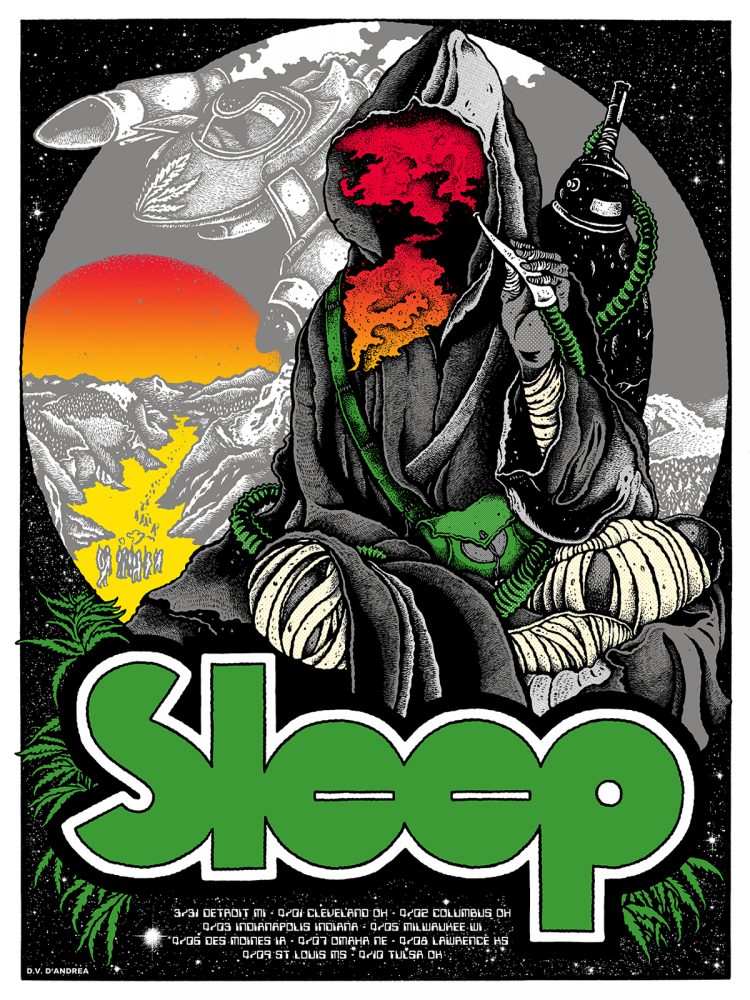
Can you list five or so of your favorite record covers?
Glyn Smyth – Ashborer The Impassable Gate: Glyn’s sense of design is so studied and simultaneously atmospheric. The Impassable Gate is an awesome example of what an album package can be.
Benjamin Vierling – Joanna Newsom Ys: I can’t imagine an album cover made with more attention to craft and detail. Vierling uses a traditional method of egg tempera and oil painting which involves a tremendous amount of time and vision.
Daniel Higgs – Atomic Yggdrasil Tarot rorschach special edition: Using an original piece of art as a tip- on album cover is obviously not viable on a large scale, nevertheless I love objects like this and managed to buy one years ago. I feel that this packaging signifies the spontaneity and creative spirit of Higgs.
Current 93 Earth Covers Earth: Classic era of C93 referencing The Incredible String Band with an incredible cult-like band photo printed in full bleed.
Tanya “Nacht” Stene – Ulver Three Journeys Through the Norwegian Netherworlde: I’ve always liked the consistency of aesthetic through the three albums, Bergtatt, Kveldssanger, and Nattens Madrigal.
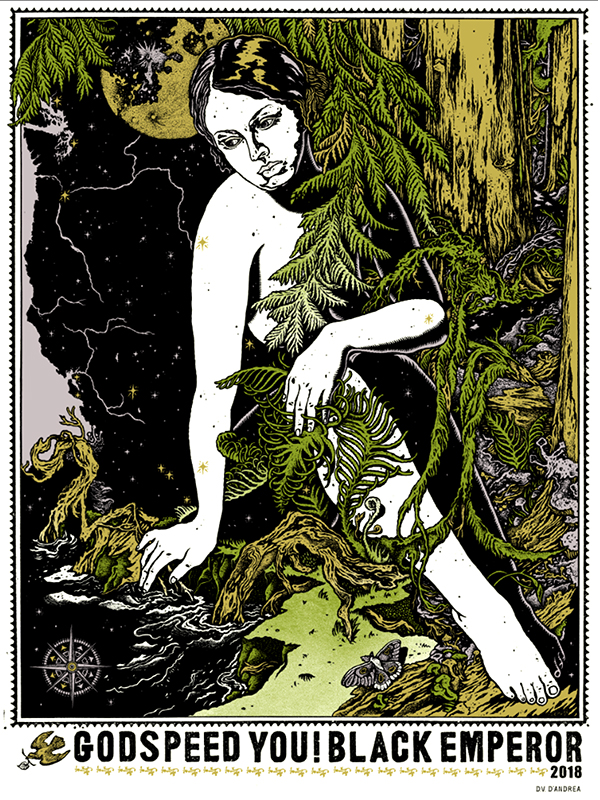
What music are you currently listening to? Maybe list five or so artists/albums.
Sukumar Prasad Pioneer of Carnatic Electric Guitar: A cassette via obscure label, Bio-Vita, which I discovered at Mississippi Records. Everything on this label is excellent and this one is a standout.
Elaine Radigue Trilogie de la Mort: This is an epic tonal journey inspired by The Tibetan Book of the Dead. I listen to it often via headphones during very long drawing sessions.
Sarah Davachi Let Night Come On Bells End The Day: Sarah is one of my favorite contemporary composers.
Robert AA Lowe Kulthan LP on Latency recordings: Rob’s entire catalog is an inspiration. He is a great friend and one of the most prolific artists I know. Cosmic light, color, and sound.
Six Organs of Admittance Dust & Chimes: It’s mossy, fungal, and personal at the same time. Everything early 6 Organs is wonderful. Dust and Chimes is just one of the last ones to see vinyl.
Zola Jesus Okovi:Additions: Zola Jesus exudes talent and emotion. Her voice has a certain resonance and honesty that speaks to my soul. This addendum to the album Okovi is made up of remixes by various artists.
Daniel Higgs Fool’s Sermon: Pure poetry.
You’ve mentioned that you read a fair bit, can you list the last few books or so that you’ve enjoyed?
“Plant Intelligence and the Imaginal Realm” by Stephen Harrod Buhner: Life changing work by Gaian earth poet Stephen Buhner. Inspiration to cultivate a direct perception of the living world by spending time in nature.
“Brion Gysin : His Name Was Master” Text and interviews by Genesis Breyer P’Orridge: The old REsearch and Rapid Eye publications of the mid 1990s were a huge influence on my life. Genesis’ enthusiasm for Gysin played a big role in that material. This book is basically composed of the raw recordings from those interviews.
“England’s Hidden Reverse” David Keenan: A reissue by Strange Attractor of a book I’ve wanted for a decade. I am a huge fan of Coil, Current 93, Nurse with Wound, and their surrounding mythologies.
“The Art of Vinyasa” Richard Freeman and Mary Taylor: This is a fantastic book on the Ashtanga practice. I realize it may be specific, but I’m answering this interview section by referencing the book pile beside my bed, and this one is certainly dog-eared.
Can you list a few contemporary artists that you would encourage people to check out and support?
Benjamin Vierling is one of my closest friends.We both began as kids who were interested in the graphics of underground punk and metal, travelers who dwelled in the universe of our ratty sketchbooks. At one point (circa 96-97) we even hung a fledgling show in a Minneapolis cafe. Our paths have run parallel in many ways.Benjamin has done a handful of album covers that readers might be familiar with but his oil/ egg tempera paintings are the crown jewels of his work. He recently wrapped up an extensive body of illustrative work for a book on Three Hands Press.
Glyn Smyth embodies the spirit of the early 1900s, an apparition alongside Dante Gabriel Rossetti and Harry Clarke. His study of art and design combined with an uncannily intuitive hand makes for some of my favorite work out there. I recently visited him and his partner Sarah (who is also a fantastic artist) at their Belfast studio. It was an incredible and inspiring time.
Jondix is a tattooer, painter, musician, illustrator, and father. I greatly admire the fluidity of his lines and also his open mind, crucial qualities which I strive towards every day. His energy and enthusiasm, whether tattooing or painting, is contagious. We’re currently working on the second installment of our collaborative show “Astral Mind” which will take place in late September in London.
Kiki Smith is an idol of mine from the older generation of New York City artists. She came from an era that I greatly admire and still produces amazing work. I model myself after her treatment of high (etching) and low (photocopies) as the same. The mark making and print process are equally as important. Kiki is a major inspiration for me.
Arik Roper will be familiar to many readers. His a soulful approach to hallucinogenic fantasy illustration has been key to the underground music world. I’m happy to call him a friend after a few decades of admiration.
I could go on and on. Jesse Draxler, Monica Canilao, Takato Yamamoto….
Any parting thoughts you would like to leave?
“Nature loves courage. You make the commitment and nature will respond to that commitment by removing impossible obstacles. Dream the impossible dream and the world will not grind you under, it will lift you up. This is the trick. This is what all these teachers and philosophers who really counted, who really touched the alchemical gold, this is what they understood. This is the shamanic dance in the waterfall. This is how magic is done. By hurling yourself into the abyss and discovering it’s a featherbed.” ~Terence McKenna
Links:
http://www.samaritanpress.org
http://www.worstward.com/
https://www.illustrationhistory.org/artists/barron-storey
https://www.yogapunxpdx.com/
https://doom.yoga
http://www.gaianstudies.org/Stephen_Interviews.html
http://www.stagandserpent.com/
http://www.bvierling.com/


